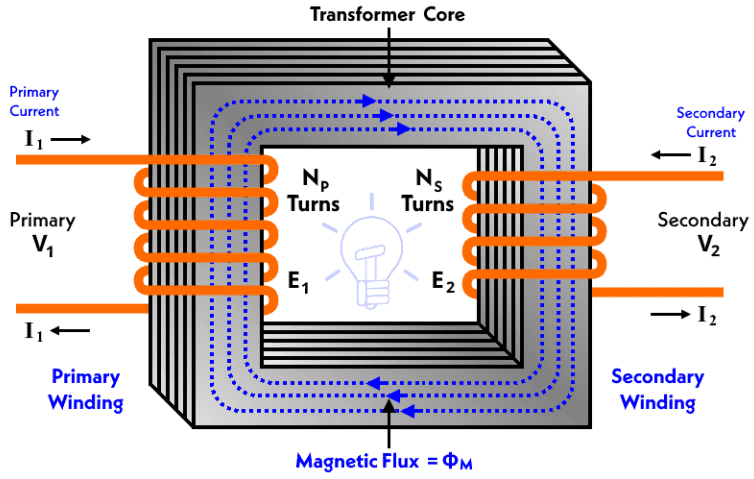There is an ideal transformer which has no copper losses (no winding resistance), no iron losses in the core, and no flux leakage.
In an ideal transformer, the output power is equal to the input power. There is no loss of power within this transformer due to its 100% efficiency. This type of transformer is impossible to exist in practice, but the ideal transformer model makes the problem easier to solve compared with the practical transformer model.
The characteristics of ideal transformer
- There is no resistance to winding: An ideal transformer is assumed to have zero primary and secondary winding resistances. Therefore, both coils are purely inductive.
- Core permeability is infinite: A higher permeability will require a lower magnetic field strength to build up the flux. Therefore, if the permeability of the transformer core is high, less magnetizing current will be required to magnetize the core.
- Permeability of the core is constant: In other words, the core has a linear B-H curve.
- There is no leakage flux: The flux set by the primary winding is connected to the secondary winding. Therefore, there is no leakage flux. It is also evident from the assumption of infinite permeability for the transformer core. The leakage flux is zero when the core permeability is infinite.
- Efficiency of 100%: There are no losses associated with an ideal transformer, such as hysteresis losses, eddy current losses, etc. An ideal transformer, therefore, has an output power equal to its input power. It is possible to achieve 100% efficiency due to the influence of winding resistance, hysteresis, eddy current and other factors.
- Electricity of low magnetization: Transformers with an ideal magnetic flux draw a very low amount of current. There is no limit to the permeability of the core of an ideal transformer.
- Regulation of zero voltage: From zero to full load secondary current, the secondary output voltage and current remain the same. Therefore, transformer voltage regulation should be zero in an ideal situation.
How does Ideal Transformer work?
The ideal transformer works on two basic principles. It produces a magnetic field when a current passes through it, and when the magnetic field in the coil changes, it generates a voltage across it. When the current in the primary coil changes, magnetic flux is created. In the secondary coil, therefore, changing the magnetic field can generate a voltage. When current flows through the primary coil, a magnetic field is created. Magnetic flux is supplied through these two windings because they are surrounded by a high core area like iron. Voltage and current will flow in the specified direction once the load is connected to the secondary coil.
The advantages of ideal transformer
- No hysteresis, eddy currents, or copper losses occur
- The coil twists perfectly determine voltage and current ratios
- There is no leakage of flux
- Non-frequency dependent
- Linearity is perfect
- There are no stray capacitances or inductances



